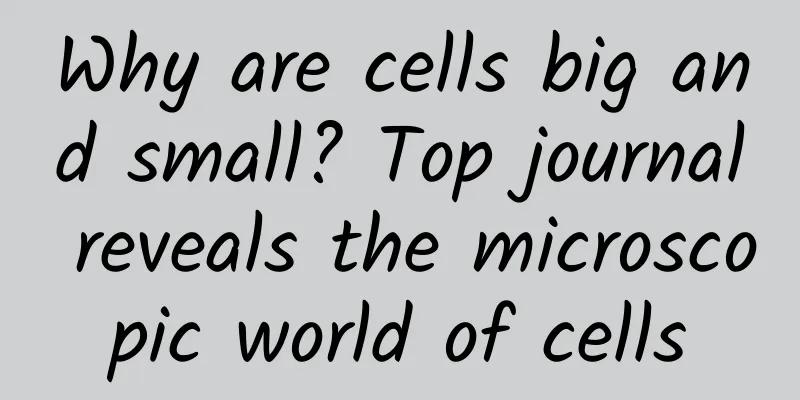Why are cells big and small? Top journal reveals the microscopic world of cells

|
Li ChuanfuHuang Ting In the vast field of biology, as the basic unit of life, cell size and morphology have always been a hot topic for scientists. So, what determines the size of a cell? The answer to this question is far more complicated than we think. Recently, Cell, a world-class journal in the field of biology, published a paper that explored the factors that affect cell size from multiple perspectives, further revealing the microscopic world of cells. Cell size usually refers to the volume of the cell, which can be estimated by measuring the diameter and height of the cell. The sizes of different types of cells vary greatly. Bacterial cells are only about one or two microns, while ostrich egg cells can reach a diameter of 5 centimeters, making them one of the largest cells. From tiny bacterial cells to huge egg cells, the volume can differ by tens of thousands of times. In addition, within the same multicellular organism, there are also huge differences in cell size. For example, in the simple multicellular organism Caenorhabditis elegans, cell size differences can span two orders of magnitude. Cell size is largely determined by genetics. Genes affect cell growth and division by controlling the progression of the cell cycle. Specific genes can encode proteins that regulate cell size. These proteins can control the synthesis and breakdown of substances within the cell, thereby affecting cell volume. The accumulation of intracellular substances is also a key factor in determining cell size. Cells gradually increase their volume by synthesizing biomacromolecules such as proteins, lipids, and carbohydrates, as well as absorbing external nutrients. The accumulation rate and efficiency of intracellular substances directly affect the growth rate and final size of cells. The living environment of cells also has a significant impact on their size. The supply of nutrients, oxygen concentration, temperature, pH and other environmental factors will affect the growth rate and metabolic activity of cells. Under suitable environmental conditions, cells can grow and divide more efficiently, thus forming larger cells. Cells do not exist in isolation; they communicate and interact with each other through signaling molecules. These interactions between cells can regulate cell growth, differentiation, and apoptosis, thereby affecting cell size. For example, some signaling molecules can promote cell growth, while others may inhibit cell growth. The size of a cell is closely related to its function. In multicellular organisms, different types of cells undertake different physiological functions, which requires them to have specific sizes and shapes. For example, muscle cells need to be large to generate force, while nerve cells need to be slender to transmit signals. From an evolutionary perspective, the diversity of cell size is the result of biological adaptation to the environment. Under different living conditions, cells of different sizes may have different survival advantages. For example, in an environment with scarce resources, smaller cells may find it easier to obtain sufficient nutrients, thereby increasing survival rates. With the development of science and technology, modern biologists have been able to precisely control cell size through gene editing, cell engineering, etc. These technologies have broad application prospects in the fields of medicine, biopharmaceuticals, etc., and can promote tissue repair and regeneration by regulating the size of stem cells. The study of cell size not only helps us understand the nature of life, but also provides new perspectives for disease treatment and health maintenance. With the deepening of research, we are expected to reveal more about the mechanisms of cell size regulation and make more contributions to improving human health and the development of biotechnology. (The author Li Chuanfu is an engineer at the Green Energy Industrial Research Center of Huazhong University of Science and Technology and a member of the Royal Society of Chemistry. Huang Ting is a master's student at Huazhong University of Science and Technology) |
<<: Father's Day丨The "invisible" changes in your body before and after becoming a father
>>: Nature News: AI "disrupts" exoskeletons to help build a strong body
Recommend
Thousands of children are injured or killed every year! Driving with a child without it is risking your life
Do you need to install a safety seat when driving...
Can foodies eat up all the invasive species? Don't overestimate the ability of foodies
Recently, the topic of invasive species has frequ...
In-depth understanding of Android's rendering mechanism
Basics CPU: Central Processing Unit, which integr...
A few branches serve as a nest, and the bird lays eggs anywhere. This bird is really a jerk.
Some time ago, citizens often shared interesting ...
WeChat: The mini-program jump to APP function has been abused and will no longer be supported
On May 14, WeChat issued a notice that "WeCh...
WeChat has launched a new function, the internal testing of the deep cleaning function, which can clean up WeChat storage space with one click
[[429252]] With the continuous update and iterati...
Twelve Baskets Weight Management Program Review, Experience the World's First Cloud Tracking Weight Management Program
In modern society, the increase in the number of &...
Good news for dieters! This oil has zero sugar, zero fat, and zero calories?
Review expert: Wang Guoyi, Postdoctoral Fellow in...
Why is the conversion effect of your copy always limited?
What is the most important feature of a copy that...
Is it true that companies will refund the social insurance and medical insurance paid in February according to regulations? Is the personal portion also exempt? See what the State Administration of Taxation says!
Affected by the epidemic, many companies are faci...
Several ways to transfer data from Android devices to iOS, master one and you can change your phone without worries
Now the price of Apple is getting more and more a...
How to break the nightmare of stagnation in particle physics?
Unless the Large Hadron Collider in Europe delive...
Information flow advertising is on the rise, and new ways of Internet marketing are emerging in the era of self-media
In the past one or two years, with the rapid deve...
Overseas Promotion and Marketing: How to Make Good Use of Tik Tok Promotion?
Generation Z refers to those born after 1995 and ...
2022 Ningbo Tea Studio is recommended to all friends
Ningbo Tea Studio recommends high-end tea SPA in-...









